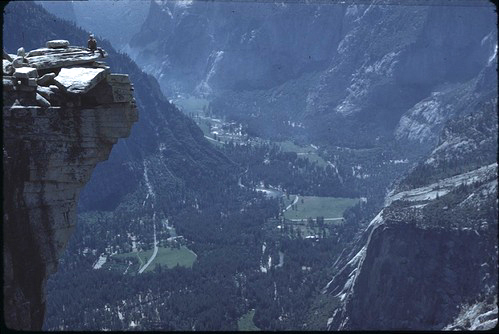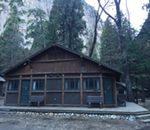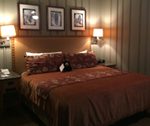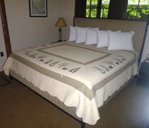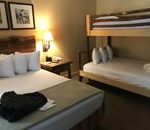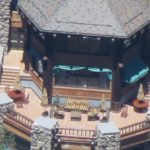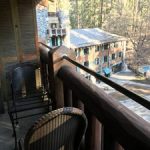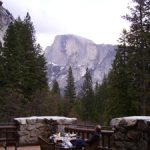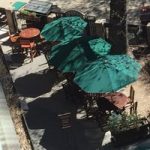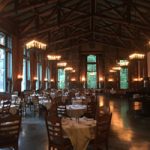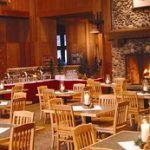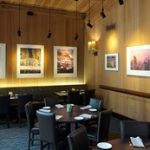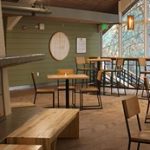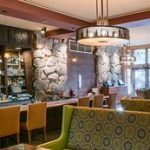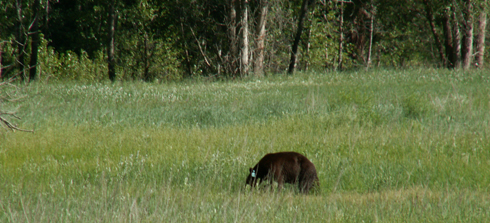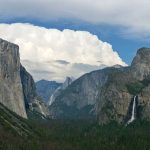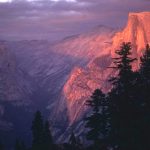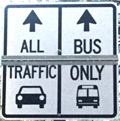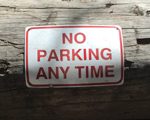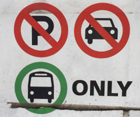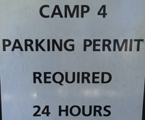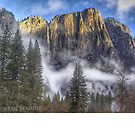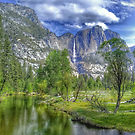Even when you have been to Yosemite Valley multiple times, the dramatic scale is still astounding. There are places in the valley where the narrow width is almost the same as the depth (height of the cliffs). The valley is only about one mile wide and seven miles long; vaguely a 120 degree angle L shape. The cliffs rise up 3,000 to 4,700 feet.
This introduction to Yosemite Valley is for students on De Anza College trips. I have used various views of Yosemite Falls to try to illustrate the size of the valley. But the only way to truly feel it is to go yourself, (in as many seasons as possible).
This picture (from the webpage backpacking advice) is taken from the top of Half Dome:
The picture below (courtesy of NPS) is was taken at Glacier Point, 3,242 feet above the valley floor on the south wall. The shot looks across the valley to Yosemite Falls on the north wall. The upper fall starts at 6,525 feet elevation and drops 1,430 feet. The lower fall starts at 5,044 feet and drops 320 feet. Adding in the distance of the middle cascade, the falls total 2,425 feet.
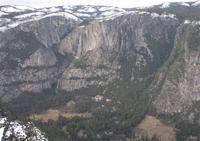
a bigger copy of the above photo is at: Yosemite Valley from Glacier Point
Here, a NPS photo of all three sections of Yosemite Falls with a rainbow, and another closer view from the trail to the upper falls:
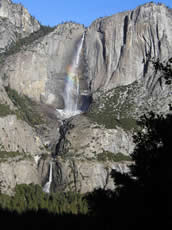

In the picture below left of Upper Yosemite Fall, taken while standing on the valley floor, the tiny tan dot in the lower left of the meadow at the bottom of the picture is a coyote looking for breakfast.
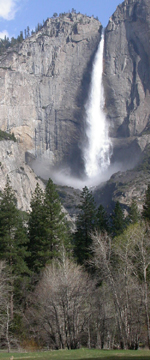
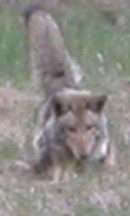
Four views of the same part of the top of the upper Yosemite Fall trail:
Upper Yosemite Fall drops 1,430 feet.
![]()
![]()

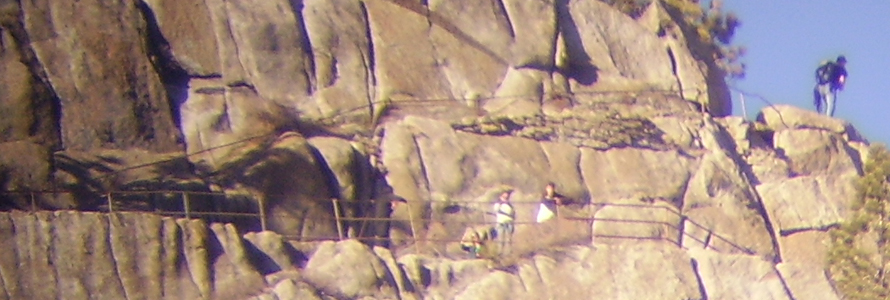
from The Yosemite , by John Muir (1912).
“The Incomparable Yosemite
The most famous and accessible of these cañon valleys, and also the one that presents their most striking and sublime features on the grandest scale, is the Yosemite, situated in the basin of the Merced River at an elevation of 4000 feet above the level of the sea. It is about seven miles long, half a mile to a mile wide, and nearly a mile deep in the solid granite flank of the range. The walls are made up of rocks, mountains in size, partly separated from each other by side cañons, and they are so sheer in front, and so compactly and harmoniously arranged on a level floor, that the Valley, comprehensively seen, looks like an immense hall or temple lighted from above.
But no temple made with hands can compare with Yosemite. Every rock in its walls seems to glow with life. Some lean back in majestic repose; others, absolutely sheer or nearly so for thousands of feet, advance beyond their companions in thoughtful attitudes, giving welcome to storms and calms alike, seemingly aware, yet heedless, of everything going on about them. Awful in stern, immovable majesty, how softly these rocks are adorned, and how fine and reassuring the company they keep: their feet among beautiful groves and meadows, their brows in the sky, a thousand flowers leaning confidingly against their feet, bathed in floods of water, floods of light, while the snow and waterfalls, the winds and avalanches and clouds shine and sing and wreathe about them as the years go by, and myriads of small winged creatures birds, bees, butterflies–give glad animation and help to make all the air into music. Down through the middle of the Valley flows the crystal Merced, River of Mercy, peacefully quiet, reflecting lilies and trees and the onlooking rocks; things frail and fleeting and types of endurance meeting here and blending in countless forms, as if into this one mountain mansion Nature had gathered her choicest treasures, to draw her lovers into close and confiding communion with her.”
This photo of John Muir and Teddy Roosevelt at Glacier Point with Yosemite Falls in the background is from the National Park Service historic photo collection:
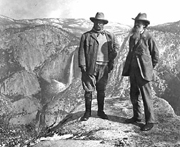
In the map below (courtesy of the National Park Service)
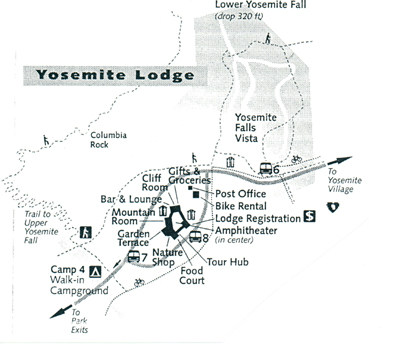
the dotted line in the upper left of the map is the trail from the valley to the base of, or the top of Upper Yosemite Fall.
see also: map of Yosemite valley
More pictures and description of the falls hike are at:
photo below by Quang-Tuan Luong/terragalleria.com, all rights reserved.
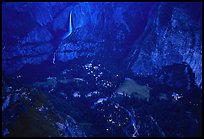
see also:
__________________________________________________
You have a number of lodging choices of where to stay overnight in Yosemite Valley in Yosemite National Park, including campsites or
wood-walled cabin without a bath; heated or unheated wood floored, canvas sided and roofed tent cabin; wood walled cabin with a bath
luxury or generic hotel rooms, suites with a bath
Ahwahnee hotel map webpage has summer and winter photos of rooms, balconies, parlors, (and the views from some of them), including the Presidential Suite with the huge balcony at the (south) far end of the Ahwahnee from the parking lot, the large third floor parlor with fireplace, two main building ADA Suites, featured room 417 with it’s own, small, private balcony, 5th floor rooms that share a balcony, the El Dorado Diggins Suite Jacuzzi tub, the 24 cottages / (bungalows / cabins), including the classic cottages that have an alcove between the bedroom and the bathroom with a bed you can fit a child on, and a door between the bedroom and alcove for privacy, sixth floor Mary Curry Tressider Suite, Library Suite, Underwood room, Sunroom Suite (Sun Porch), Mather, Spencer.
__________________________________________
casual, fast (grab and go)
or with table-side service,
indoor and outdoor food service
The Yosemite National Park rangers would like you to call them
if you see a bear in Yosemite,
no matter where it is or what it is doing.
Since 2003 there has been a note in the Yosemite Guide: “REPORT ALL BEAR SIGHTINGS! To report bear sightings, improper food storage, trash problems, and other bear-related problems, leave a message for the Bear Management team at: 1 (209) 372-0322. Your call can be made anonymously.”
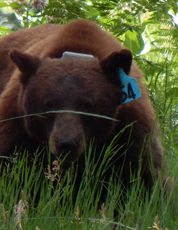
If you can, in all the excitement, try to notice if the bear has a tag (usually on the ear), the color of the tag and if possible, the number on it (the tag is large enough that with a telephoto lens you should be able to read the number).
From the Yosemite Daily Report newspaper:
“It is extremely important to remember to yell at bears that are in and around development, even if they are foraging on natural food. Though it is very tempting to get close for a picture, or just to watch these incredible animals, it is important not to give into this urge. Yelling at them if they are in residential areas or near people is critical to keep bears natural fear of humans. Giving bears plenty of space. When bears become too comfortable around people, they will often start causing damage to structures and vehicles, or will even become too bold around people, creating safety concerns.”
And the Yosemite Daily Report also said:
“Scare bears when you see them. . . in developed areas- Yell like you mean it!
Make as much noise as possible, try waving your arms, stomping your feet
or anything to make you look intimidating and to get the bear to run away.
We know it’s fun to see bears and it can feel mean to scare them,
but this is a simple way to truly help save a bear’s life.”




Where were they when they got that great picture in Yosemite?
Where can I take a photo that looks like the one on a Yosemite postcard I just bought?
Places to take photos of Half Dome, Bridalveil Fall, El Capitan, Yosemite Falls and Staircase Falls.
Yosemite nature podcasts: http://www.nps.gov/yose/photosmultimedia/ynn.htm episode #2 is Yosemite Falls
Yosemite Valley free shuttle bus
– – – – – – – – – – – – – – – – – – – – – – – – – – – – – – – – – – –
Drivers should note that there have been sections of road in Yosemite Valley, part of the year, with two lanes (usually) in the same direction, with the right lane ONLY for the free shuttle buses, ambulances, ski bus, commercial vehicles with ten or more passengers. The NPS says: “The bus lane ensures emergency vehicles can respond to incidents when traffic is backed up and provides preference for mass transit.”
Yosemite nature and photography links
Yosemite Valley Rafting Advice
Photos below by Eric Kulikoff http://www.redbubble.com/people/erickulikoff all rights reserved.
